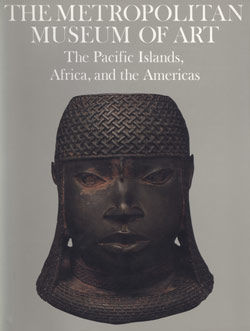Canoe Figurehead (Nguzu Nguzu, Musu Musu, or Toto Isu)
Not on view
In Solomon Islands canoes were essential to transportation, fishing, and warfare. The canoe house was the ceremonial center of the village, while canoes themselves were often lavishly adorned with shell inlay, carved decoration, and protective charms. In the western islands of New Georgia, Choiseul and Santa Isabel, large tomako (war canoes) would be adorned with distinctive figureheads. Known as nguzunguzu in the Roviana Lagoon area of New Georgia and toto isu in the Marovo Lagoon area on the opposite side of the island, canoe prow ornaments combine a human-like head with pronounced jaw, elongated head and often shell inlay designs that replicate facial paint or tattoo markings. The figures are carved without a body but with shoulders and arms either clutching a bird, human head or other object in its hands, or, as in this example, pressing its hands together below the chin.
There are numerous stories of the origin of nguzunguzu as well as several explanations for their distinctive features. According to one origin story from Roviana Lagoon, the nguzunguzu is carved in the image of Tiola, a mythological ancestor who took the form of a dog. Tiola taught the people of Roviana to build the first tomako, and the likeness of his head and hands at the prow of the canoe served to fight enemies. Other accounts refer to the figure as an embodiment of Kesoko, a water spirit that acted as a pilot and protector of the vessel. Across the different stories of the origin of nguzunguzu, there is a strong connection between the figureheads and practices of ritual warfare and headhunting. The aim of headhunting was to acquire mana, or spiritual power, from the individual who was killed, which could in turn be channeled into the consecration of war canoes, and the overall protection and health of the village.
On this figure, nautilus shell inlay has been used to create the effect of facial paint and decorated ear plugs. The shimmer of white shell inlay against the stained black wood is a distinctive feature of Solomon Islands art, where the luminous quality of the shell creates visual efficacy and signifies ancestral presence. Body paint designs rendered in shell inlay could also be found in the decoration of canoes themselves. Both the human body and canoes are seen as vessels capable of harnessing ancestral power when properly adorned.
Nguzunguzu would be lashed at the base of the tall prow so that the figure skimmed the surface as the canoe cut through the water. Being tied to the prow rather than carved as an integral part of the canoe prow meant that nguzunguzu could be removed from vessels captured in warfare, or exchanged as high-status items and may have been used to adorn several canoes in their lifetimes.
In the decades following Solomon Islands’ independence from the United Kingdom in 1978, the nguzunguzu has taken on an iconic role as a national and cultural symbol with artists continuing to draw on the canoe prow figures as inspiration. The historical association with headhunting is retained in these contemporary renderings as a connection to their ancestral power by descendants. Stories told today by contemporary makers indicate that a figure holding a head between its hands is a harbinger of war, while those holding birds come in peace.
Due to rights restrictions, this image cannot be enlarged, viewed at full screen, or downloaded.
This artwork is meant to be viewed from right to left. Scroll left to view more.







